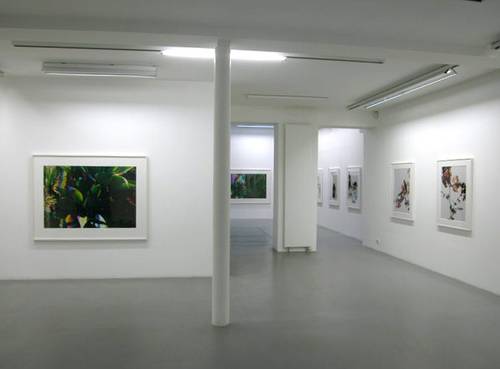James Welling
04 Nov - 22 Dec 2006
JAMES WELLING
Galerie Nelson is pleased to present new four series of photographs by James Welling.
Since his groundbreaking 1980 photographs of aluminum foil, James Welling’s work has interrogated photographic representation. In these recent works Welling looks intensely at color vision and at a set of interrelated questions concerning the materiality of photography. Welling’s works have been largely seen in USA and Europe : in 2000, he had a retrospective show at the Wexner Center for the Arts which travelled to the LACMA. In 2002, a second retrospective took place in Europe, at the Palais des Beaux Arts in Brussels and recently, some of these photographs of L.A. were shown at the Centre Pompidou in the show « Los Angeles 1955 – 1985 »
Flowers
To create his Flowers, 2004-2005 James Welling made a group of photograms of flowers on black and white 24 x 20 cm film. He then printed each negative in one of Newton’s 7 “primary” colors (red, orange, blue, green, yellow, indigo and purple) on large sheets of Kodak Endura Metallic chromogenic paper. In 2005 Welling made a new suite of photograms with multiple colors on the same sheet of paper. A second set these images were printed in a rust colored monochrome.
Hexachromes
For a number of years Welling has been experimenting with different ways of making color photographs using separation filters. By exposing film through red, green and blue Kodak tri-color separation filters, the images dissect additive color vision, which is both the foundation of color photography and of human vision. In his Hexachrome Photographs, 2006 Welling takes the tri-color process one step further by exposing color negative film through 6 color filters (red-green-blue and cyan-magenta-yellow.) In the resulting images, shadows moving across the subject (agave plants) are recorded as intense swaths of color.
Rocks
This series of straight-forward gelatin silver prints of beach rocks in Goleta, north of Santa Barbara, California underlines Welling’s long standing exploration of abstraction and natural processes. Each tidal change produces a new composition. Over a period of days, Welling photographed the same 200 meter coastline to record the ongoing movement of rocks and sand.
Quadralaterals
In these completely digital images Welling continues to explore random processes and photographic abstraction. To begin the Quadralerals, Welling created and scanned 90 four-sided flat cardboard shapes. These were then entered into the three-dimensional program Maya. The digital quadralateral shapes were randomly scattered in the program and, using a mouse, Welling captured/photographed small configurations of shapes. Virtual shadows were added to indicate a directional light. Echoing Welling’s previous abstract series ---Tile Photographs 1985 and New Abstractions, 1998--- the Quadralaterals force the viewer to ask what it is that they are looking at when confronted with an abstract photograph.
© James Welling
Exhibition view, Galerie Nelson, Paris
2006
Galerie Nelson is pleased to present new four series of photographs by James Welling.
Since his groundbreaking 1980 photographs of aluminum foil, James Welling’s work has interrogated photographic representation. In these recent works Welling looks intensely at color vision and at a set of interrelated questions concerning the materiality of photography. Welling’s works have been largely seen in USA and Europe : in 2000, he had a retrospective show at the Wexner Center for the Arts which travelled to the LACMA. In 2002, a second retrospective took place in Europe, at the Palais des Beaux Arts in Brussels and recently, some of these photographs of L.A. were shown at the Centre Pompidou in the show « Los Angeles 1955 – 1985 »
Flowers
To create his Flowers, 2004-2005 James Welling made a group of photograms of flowers on black and white 24 x 20 cm film. He then printed each negative in one of Newton’s 7 “primary” colors (red, orange, blue, green, yellow, indigo and purple) on large sheets of Kodak Endura Metallic chromogenic paper. In 2005 Welling made a new suite of photograms with multiple colors on the same sheet of paper. A second set these images were printed in a rust colored monochrome.
Hexachromes
For a number of years Welling has been experimenting with different ways of making color photographs using separation filters. By exposing film through red, green and blue Kodak tri-color separation filters, the images dissect additive color vision, which is both the foundation of color photography and of human vision. In his Hexachrome Photographs, 2006 Welling takes the tri-color process one step further by exposing color negative film through 6 color filters (red-green-blue and cyan-magenta-yellow.) In the resulting images, shadows moving across the subject (agave plants) are recorded as intense swaths of color.
Rocks
This series of straight-forward gelatin silver prints of beach rocks in Goleta, north of Santa Barbara, California underlines Welling’s long standing exploration of abstraction and natural processes. Each tidal change produces a new composition. Over a period of days, Welling photographed the same 200 meter coastline to record the ongoing movement of rocks and sand.
Quadralaterals
In these completely digital images Welling continues to explore random processes and photographic abstraction. To begin the Quadralerals, Welling created and scanned 90 four-sided flat cardboard shapes. These were then entered into the three-dimensional program Maya. The digital quadralateral shapes were randomly scattered in the program and, using a mouse, Welling captured/photographed small configurations of shapes. Virtual shadows were added to indicate a directional light. Echoing Welling’s previous abstract series ---Tile Photographs 1985 and New Abstractions, 1998--- the Quadralaterals force the viewer to ask what it is that they are looking at when confronted with an abstract photograph.
© James Welling
Exhibition view, Galerie Nelson, Paris
2006

